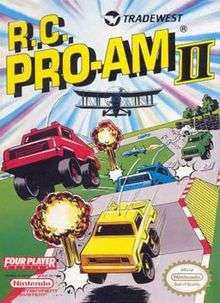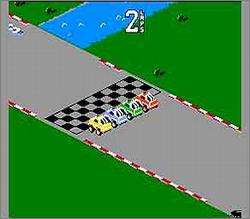R.C. Pro-Am II
R.C. Pro-Am II is a racing video game developed by Rare and released by Tradewest for the Nintendo Entertainment System on December 11, 1992. The game is the sequel to the 1988 R.C. Pro-Am and features similar gameplay with a wider variety of tracks, currency-based vehicle and weapon upgrades, and bonus stages. In R.C. Pro-Am II, four players, either human or artificial intelligence, race on a series of tracks to finish first while avoiding obstacles and hazards. The winner receives race points and money. The game features a multiplayer mode in which up to four human players can compete against each other simultaneously.
| R.C. Pro-Am II | |
|---|---|
 | |
| Developer(s) | Rare |
| Publisher(s) | Tradewest |
| Composer(s) | David Wise |
| Platform(s) | Nintendo Entertainment System |
| Release | December 11, 1992 |
| Genre(s) | Racing/Vehicular combat |
| Mode(s) | Single-player, multiplayer |
Reviewers praised the sequel's additional features and variety, while others found its gameplay unoriginal compared to the original and its contemporaries. Critics lauded the multiplayer mode, which some said was a reason alone to buy the game. The game was released in Rare's 2015 Rare Replay compilation for Xbox One.
Gameplay
R.C. Pro-Am II is a racing video game in which four vehicles compete on a series of 24 different tracks: eight standard racetracks, eight "cityscape" tracks, and eight offroad tracks. The difficulty level increases between each type of course. Players must navigate around course obstacles to finish the race. In the single-player mode, the players races against three artificial intelligence opponents. The game also has a multiplayer mode in which up to four human players can race against each other. The objective of each race is to finish in the top three places to receive race points and money, which is used to upgrade vehicles and buy weapons. The top three finishers are qualified to participate in the next race while other players must use a continue. The game ends when the players run out of continues.[1]
Players steer with the directional pad, accelerate with one button, and fire their weapon with the other.[2] Before each race, players can use money earned from previous races to buy vehicle performance upgrades and weapons, which can be used on other competitors. Upgrades and weapons include the following: motors (increased speed); tires (better turning); missiles, bombs, and "freeze beams"; and buckshots (steal opponents' cash). Other purchasable goods include additional ammunition. Players can save money to purchase better, more expensive upgrades later in the game.[1] Players can also collect letters that spell "PRO AM II" that are scattered on the track. Upon finishing the collection, the player receives a new, faster vehicle with tighter controls.[3] Track terrain varies, including winter environments, crossroads, and rivers.[2] Track hazards like water, bombs, mud, ice, ridges, oil, and bomb-dropping aircraft slow player speed. The game includes two types of bonus stages (tug of war and drag race) that award race points and cash.[1]
Reception

R.C. Pro-Am II was developed by Rare and published by Tradewest. It was released for the Nintendo Entertainment System in December 1992.[4] Nintendo Power praised the game's controls and upgrade options, which made the game strategic. The magazine criticized the difficulty as unfair, with aircraft hazards that gave players no reaction time in which to dodge attacks.[5] Nintendo Magazine System praised the game overall and its multiplayer in particular, but felt that better games were available.[6] In 1993, GamePro said that the game was better than its predecessor, but noted that the graphics and sound could have been better.[7] Jeuxvideo.com appreciated how the sequel's cars had better traction, but thought the game was technically unrefined considering its few advances in four years' time. For example, they criticized Rare for recycling the original game's audio.[2] In 1994, Game Players had high praise for the game's multiplayer, screeching sound effects, vehicle handling, and replay value. They criticized its lack of in-game music and current weapon indicators, and struggled to anticipate turns in the track in the game's angled perspective.[8]
Retrogaming magazine Retro Gamer said that R.C. Pro-Am II was not substantially different from its predecessor. They found the racing game mechanics similar apart from the upgrade features. The reviewer added that players expected more, especially for a title that was released five years after the original. He also noted that while the single-player mode was "passable", the multiplayer mode was what made the game stand out on its own, providing "excellent gaming despite its lack of originality".[9]
R.C. Pro-Am II was named Nintendo Power's best NES game of 1993 over Battletoads & Double Dragon and Kirby's Adventure. The magazine credited the game's excellent controls and course variety.[10] R.C. Pro-Am II is included in Rare Replay, a compilation of 30 Rare titles, released on the Xbox One on August 4, 2015.[11]
References
- "R.C. Pro-Am II". Nintendo Power (44): 88–91. January 1993.
- Goten67 (March 8, 2012). "Test : R.C. Pro-Am II". Jeuxvideo.com (in French). Webedia. Archived from the original on December 22, 2015. Retrieved August 13, 2015.
- "R.C. Pro-Am II". Electronic Gaming Monthly (42): 225. January 1993.
- "NES Games" (PDF). Nintendo. Archived from the original (PDF) on March 17, 2007. Retrieved September 13, 2015.
- "Now Playing". Nintendo Power (44): 105, 107. January 1993.
- "R.C. Pro-Am II". Nintendo Magazine System. 1992.
Definitely a great game, but there are greater. If you really have to have a four-player game, then get this. Otherwise take a look at the others.
- Slo Mo (May 1993). "Nintendo Pro Review – R.C. Pro-Am II". GamePro. San Mateo, CA: GamePro Publishing (45): 34. ISSN 1042-8658. OCLC 19231826.
- "R.C. Pro-Am II". Game Players. No. 41. June 1994. p. 66.
- Burton, Richard (December 2010). "Back to the Nineties". Retro Gamer. Imagine Publishing (84): 24. ISSN 1742-3155.
- "Nintendo Power Awards 1993". Nintendo Power (60): 57. May 1994.
- McWhertor, Michael (June 15, 2015). "Rare Replay for Xbox One includes 30 Rare games for $30 (update)". Polygon. Vox Media. Archived from the original on June 16, 2015. Retrieved June 16, 2015.